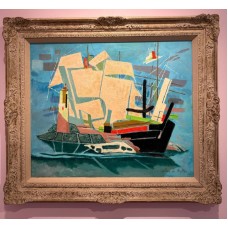Jean De Botton
Jean Isy De Botton was part of the Ecole de Paris or School of Paris, a group of both French and non-French artists living in Paris between the two world wars. He had a long and prolific career. His successful career started in the 1920s and continued for four decades. He received a degree in Philosophy from the Lycée Rollins in Paris he went on to travel extensively and become a well-established artist. De Botton's early paintings display many of the characteristics of the age of Art Deco, incorporating romantic, allegorical, and historical themes with a modern technique. In a career that spanned five decades de Botton’s early work reflected a love of pageantry—perhaps this was the reason he was the only non-British painter officially invited to attend and paint the Coronation of King George VI in 1937—and his late paintings were abstract. Born in France in 1898, Jean de Botton enrolled in the Ecole des Beaux-Arts in Paris in 1920 to learn fresco painting. On a trip to Spain in 1925 he encountered the art of Zurbaran and El Greco; then on his return to Paris he discovered Cezanne and began an intensive study of Impressionism, Post Impressionism and early 20th century art movements. De Botton participated in the important yearly Paris exhibitions: Salon d’Automne and the Salon des Independants; he was included in the 1934 to 1938 Carnegie Institute Internationals in Pittsburg, Boston and Chicago; and in 1936 he was included in official exhibitions of French art in Tokyo, Brussels and Antwerp. By the late 1950s de Botton was only painting imaginary landscapes, still lifes and abstracts. He could finally say he had achieved his own style, something he viewed as the crown of artistic pursuits. De Botton’s paintings were acquired by the Albertina Museum, Carnegie Institute, Dallas Museum, Fogg Art Museum, Metropolitan Museum of Art, Musée National d’Art Modern, Paris, High Museum, Norton Museum, San Diego Museum and the Museum Richartz, Cologne.

